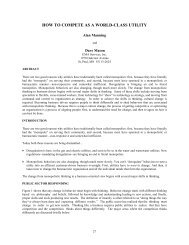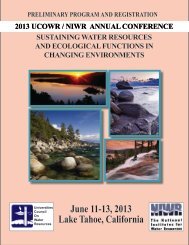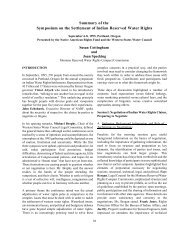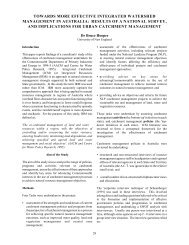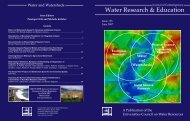Full Journal of Contemporary Water Research and Education, Issue ...
Full Journal of Contemporary Water Research and Education, Issue ...
Full Journal of Contemporary Water Research and Education, Issue ...
Create successful ePaper yourself
Turn your PDF publications into a flip-book with our unique Google optimized e-Paper software.
116McKayFigure 1. The four paradigms in Australian surface <strong>and</strong> ground water management.approach was represented by the mantra “populateor perish” under the incentive <strong>of</strong> “turning waterinto gold” (Powell 1999, Sinclair 2001).Paradigm 2 was characterized by large Stateworks <strong>and</strong> schemes <strong>and</strong> some federal funding <strong>of</strong>these <strong>and</strong> funding <strong>of</strong> works on the basis <strong>of</strong> specialissues in a State such as flood control, irrigationworks, <strong>and</strong> salinity on the Murray (Hallows <strong>and</strong>Thompson 1999). Large dam storage in 1901amounted only to 249 GL (Gigaliters or 10 9 liters)but, by 1950, it had increased to 9,509 GL <strong>and</strong> by1990 to 78,919 GL (Broughton, 1999). A third <strong>of</strong>this storage is in New South Wales <strong>and</strong> anotherthird is in Tasmania (essentially for hydropowergeneration). Most <strong>of</strong> the additions to storageoccurred during 1960–79 because it was duringthis period that dams, with a total capacity <strong>of</strong>50,000 GL, were constructed (Broughton, 1999).Despite section 100, the Commonwealth hasintervened in State water management throughSections 81 <strong>and</strong> 96 <strong>of</strong> the Constitution whichgives the Commonwealth power to grant financialassistance to the States <strong>and</strong> impose conditions. Inthis context, the emergence <strong>of</strong> salinity problemswas identified as a key issue, especially along theRiver Murray. In 1978, the Commonwealth passedthe National <strong>Water</strong> Resources Financial AssistanceAct which funded a broad range <strong>of</strong> works aimingto conserve water <strong>and</strong> mitigate salinity <strong>and</strong> floods,particularly in the Murray-Darling Basin (seeMurray-Darling Basin Commission 2006). Thegreat Artesian Basin Rehabilitation Program c<strong>of</strong>undedby the Commonwealth <strong>and</strong> three States ,was started in 1989 to cap bores <strong>and</strong> hence stopdepletion. The Federal Government also intervenedusing the trade <strong>and</strong> commerce power <strong>and</strong> externalaffairs power under section 51 to prevent theCrown in right <strong>of</strong> Tasmania from building a damin 1983 (Commonwealth v Tasmania 1983). Morerecently, these powers have been used to pass theCommonwealth Environmental Protection <strong>and</strong>Biodiversity Act by incorporating provisions <strong>of</strong>the Ramsar Convention on wetl<strong>and</strong>s into the Act.Hence this phase is characterized by uncoordinatedissue-driven intervention <strong>of</strong> the federal governmentin water management issues.Paradigm 3 from 1994 represents the Federalgovernment imposing more structured generalreform targets on the States. The federalgovernment’s stake in Australia’s water affairschanged significantly with the incorporation <strong>of</strong>water management into the CoAG competitionframework. National competition policy, whichincluded the part or full sale <strong>of</strong> several publicenterprises, created a pool <strong>of</strong> funds by whicheach state could be “encouraged” to followUCOWRJOURNAL OF CONTEMPORARY WATER RESEARCH & EDUCATION



